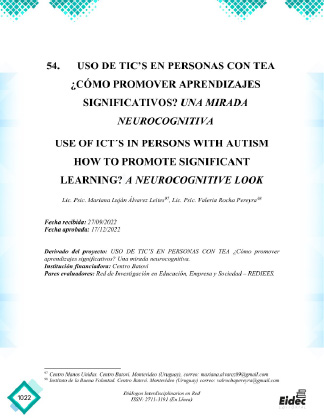LIV. USO DE TIC’S EN PERSONAS CON TEA ¿CÓMO PROMOVER APRENDIZAJES SIGNIFICATIVOS? UNA MIRADA NEUROCOGNITIVA
##plugins.themes.bootstrap3.article.main##
Resumen
En las últimas décadas, los avances de la comunidad científica en torno a la
clasificación del Trastorno del Espectro Autista lo posicionan como un trastorno del
neurodesarrollo el cual se observa desde los inicios de la vida.
Esto implica un cambio de paradigma debido a la posibilidad de detección y
diagnósticos tempranos. La intervención en primera infancia habilita el desarrollo de la
neuroplasticidad, así como determina una mejor evolución y pronóstico a largo plazo. Los
diagnósticos tardíos no permitían intervenir en la adquisición de las habilidades, sino desde
el déficit de las mismas.
Es menester puntualizar el avance sustancial que suscitan las Tecnologías de la
Información y la Comunicación en torno al trabajo en discapacidad brindando nuevas
modalidades comunicacionales y formas de autonomía, siendo indispensable entonces
trabajar desde la confluencia de: detección temprana e intervenciones tecnológicas.
El uso responsable, sistemático y progresivo de las TIC´s genera avances en torno a
la memoria, percepción visual, coordinación perceptivo motriz, atención conjunta, sostenida
y selectiva, imitación, reforzamiento de las habilidades asociadas a la adquisición del
lenguaje escrito, comprensión y aprendizaje de habilidades básicas, así como decodificación
de emociones.
Nuestra misión es crear un plan de trabajo específico, personalizado y eficaz, basado
en la motivación, mediante herramientas tecnológicas para lograr avances neurocognitivos y
sociales. Al mismo tiempo, el núcleo familiar se verá empoderado al obtener nuevos modos
de vincularse con la persona con Trastorno del Espectro Autista.
Download Statistics
##plugins.themes.bootstrap3.article.details##
Tecnología, Autismo, TIC’S, Neurocognición, Aprendizaje, Detección temprana, Dopamina.
y la amígdala en procesos de plasticidad sináptica. Una clave para entender las
relaciones entre motivación y memoria. Revista de Neurología 35 (6): 586-593.
[2] APA (1987), Diagnostic and statistical manual of mental disorders (3ªed. revisada)
(DSM-III-R), Washington, D.C., American Psychiatric Association (trad. Cast. En
Barcelona, Masson, 1988).
[3] APA (2014). Manual diagnóstico y estadístico de los trastornos mentales (DSM-5)
(Quinta edición). Madrid: Editorial Médica Panamericana.
[4] Aparicio Pico, E; Rodríguez Casas, J; (2016) Un análisis del autismo desde la perspectiva
de su influencia en familias y la tecnología como facilitador en el manejo de esta
condición. Revista Logos, Ciencia & Tecnología, vol. 8, núm. 1. Colombia
[5] Artigas Pallarés, J. (2011) ”Trastornos del neurodesarrollo“ .España.
[6] Artigas-Pallares, J. (2009) Modelos cognitivos en el trastorno por déficit de
atención/hiperactividad. Revista de Neurología 49 (11): 587-593
[7] Belloch, Consuelo (SF) Recursos tecnológicos para personas con problemas graves de
comunicación. Unidad de Tecnología Educativa (UTE). Universidad de Valencia
[8] Berke, J (2018) What does dopamine mean? Nature Neuroscience volume 21, pages787–
793. USA
[9] Benites Morales, Luis (2010) Autismo, familia y calidad de vida. Escuela Profesional de
Psicología. Revista de la Asociación de Docentes de la USMP Nº. 24. Recuperado
de: https://dialnet.unirioja.es/servlet/articulo?codigo=3701024
[10] DeYoung, C (2013) The neuromodulator of exploration: A unifying theory of
the role of dopamine in personality.Front Hum Neurosci. 2013; 7: 762.
[11] Durán Cuartero, S (2021) Tecnologías para la enseñanza y el aprendizaje del alumnado
con Trastorno del Espectro Autista: una revisión sistemática. Innoeduca. International
Journal of Technology and Educational Innovation Vol. 7. No. 1. Junio 2021 - pp.
107-121 - ISSN-e: 2444-2925. España.
[12] Elvira Valdez, M (2010) Motivación y Neurociencia: Algunas Implicaciones
Educativas. acción pedagógica , Nº 20 / Enero - Diciembre, 2011 - pp. 104 - 109.
Colombia [13] Kanner, Leo (1943) Autistic disturbances of affective contact. Journal Nervous Child.
Traducción de: Teresa Sanz Vicario
[14] Mesurado, B (2008) Explicaciones psicológicas sobre la motivación y el sustrato
neurobiológico que posibilita la misma.Psicología y Psicopedagogía. Publicación
virtual de la Facultad de Psicología y Psicopedagogía de la USAL Año VII Nº 19 -
Julio de 2008. Argentina.
[15] OCDE & CERI (2009) La comprensión del cerebro. El nacimiento de una ciencia del
aprendizaje. Ed. Universidad Católica Silvia Henríquez, Santiago de Chile.
[16] Palacios, Agustina (2008), El modelo social de discapacidad: orígenes, caracterización
y plasmación en la Convención Internacional sobre los Derechos de las Personas con
Discapacidad, Cinca, Madrid. Pérez Bueno, Luis (2010), Discapacidad, derecho y
políticas de inclusión, Cinca, Madrid.
[17] Posner, M. & Petersen, S. (1990) The attention system of the human brain. Annu. Rev.
Neurosci. 1990.13:25-42. Recuperado de: http://arjournals.annualreviews.org
Harvard College
[18] Real Academia Española. (2014). Diccionario de la lengua española (23a ed.).
[19] Reaño, Ernesto (SF) La Tríada de Wing y los vectores de la Electronalidad: hacia una
nueva concepción sobre el Autismo. Recuperado de:
https://www.academia.edu/11795285/La_Tr%C3%ADada_de_Wing_y_los_vectore
s_de_la_Electronalidad_hacia_una_nueva_concepci%C3%B3n_sobre_el_Autismo?
ends_sutd_reg_path=true
[20] Tobón, S.,ME. (2012). Detección temprana de autismo ¿es posible y necesaria?. Revista
CES Psicología, 5(1), 112-117.
[21] Wing L (1981). «Asperger's syndrome: a clinical account». Psychol Med 11 (1): 115-
29.
[22] Wing, L. & Potter, D. (1999) Apuntes sobre la prevalencia del espectro autista.
Congreso Autism99. Recuperado de: http://espectroautista.info/prevalencia.html
Traducción de: Miriam Cobian





